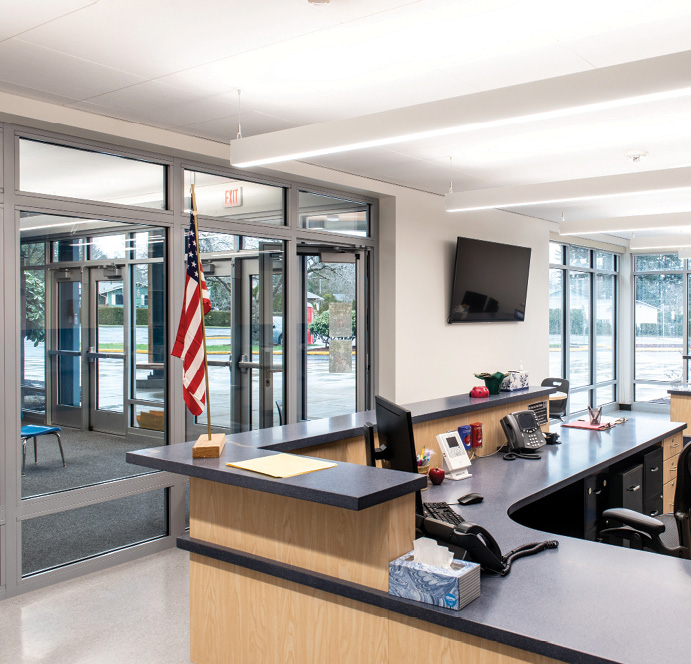Enhanced School Security Solutions
Transparent, protective glazing can be a viable option for hardening schools on both the exterior and interior layers
The Bottom Line: Understanding various security ratings—where they fit in safer school design and how they interact with other specialty glazing—can help building professionals plan protections for areas where multiple life safety and security threats overlap, both now and in the future.

Designing safer schools is no easy task. Architects are often asked to balance code-driven, free-egress requirements and recommended access control for safer and more secure schools. It is also important to create interiors that support students’ educational and psychological needs.
Glazing is central to these considerations. It can allow daylight to illuminate interiors and provide visual connections between adjacent spaces—both inside and outside the built environment. Aesthetically, visual connection grounds occupants within the surrounding landscape; it also supports crime prevention through environmental design. Glass, however, can also be seen as a weak point in doors and along the building envelope.
But it does not have to be. Transparent, protective glazing can be a viable option for hardening schools on both the exterior and interior layers. To use such glazing effectively, it is important to understand current ratings, how they achieve code compliance and where they fit within security best-practice recommendations.
Meeting security best practices
Security guidelines from the Partner Alliance for Safer Schools recommend using a multilayered approach for school security. These layers place several obstacles between assailants and occupants to delay intruders and fortify shelter-in-place locations to allow occupants more time to alert first responders and take appropriate action.
Forced-entry-rated glazing systems support both goals. Tested to the ASTM F3561 standard, forced-entry-rated glazing helps defend against physical attack to slow the ingress of a violent attacker. The intention is to buy occupants more time to enact district and campus security protocols—an example of multiple security layers reinforcing one another.
Another type of protective glass is ballistic-rated glazing. These systems are tested to UL 752 standards and receive a rating based on the number of shots and what caliber of round they can stop. This glazing places a transparent barrier between an armed attacker and occupants.
While it may be tempting to see one rating type as more or less secure than the other, both ratings have different uses and applications. For example, forced-entry glazing can be placed in entryways to delay intruders while ballistic-rated assemblies can fortify shelter-in-place locations. As such, glaziers and specifiers are encouraged to work with security professionals to assess which glazing type is more suitable for an application.
Maintaining free egress
While conversations around safer school design and protective glazing often focus on security-rated glass, this approach to construction also encompasses other life safety threats, including fire. According to the National Fire Protection Association, there are over 7,000 fires on school campuses each year, and nearly two-thirds occur during school hours.
Transparent, fire-rated glazing has been around for decades. It allows architects to meet current egress codes without sacrificing light-filled and visually connected interiors. Despite the added emphasis on school security, however, there has been little discussion about how security ratings impact fire-rated glass.
Security-rated components are often plastic-based and burn at rates and intensities that exceed current fire test parameters. This may reduce or entirely negate a system’s fire rating. Building professionals can plan for enhanced security without compromising fire and life safety by using components that are known to be compatible. They can also specify multifunctional, fire-rated glazing assemblies that have been tested as a complete system. Doing so will ensure protective glazing will perform as intended in applications where security goals and fire- and life-safety codes intersect.
Updating building codes
The need to anticipate component compatibility can be seen as symptomatic of a larger issue within the design and glazing communities. Because specifying incompatible components can potentially put lives at risk, it is important that model building codes address safety and security as well as egress and ingress. This will help establish a baseline of security and give architects a reference point for planning safer schools.
Although these updates may feel distant, understanding various security ratings, where they fit in safer school design and how they interact with other specialty glazing can help building professionals plan protections for areas where multiple life safety and security threats overlap—both now and in the future.


